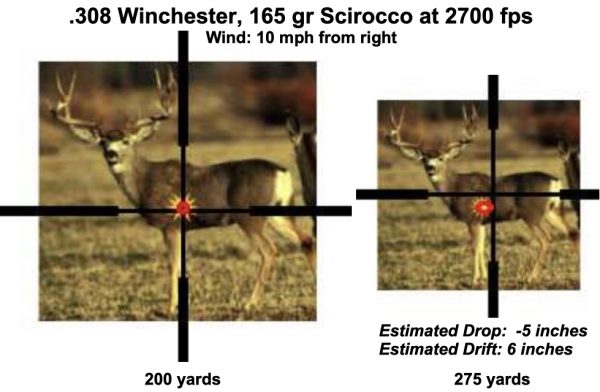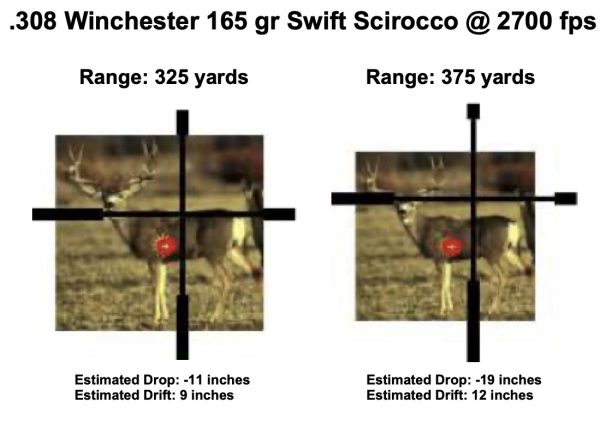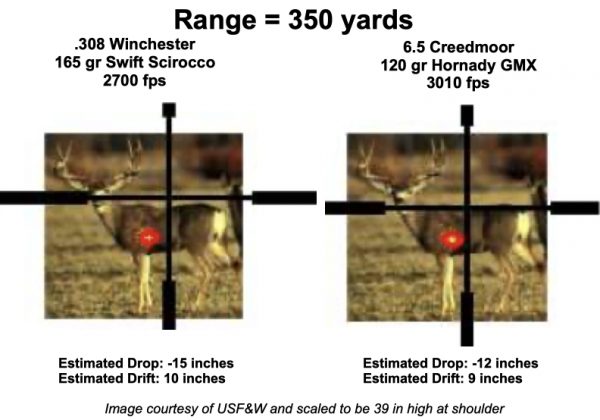Your favorite rifle is sighted to point of aim at 200 yards and that pesky deer shows up at 275 yards. What is the sight picture needed to center in the vital zone?
“Point Blank Range Revisited” illustrates that a straightforward sight-in placing the group 1.5 inches high at 100 yards is easier to do and will be very close to the theoretical point blank range for most rifles. It is also close to a 200 yard zero for many rifles.
“Sighting in for Hunting: A New Approach” describes a method that gives confidence that your rifle’s first three shots will be within .8 moa (~10-inch dia circle at 300 yards) of the desired impact on average.
“The Fouling Shot” helps you to explore the importance of a dirty versus clean bore for your rifle and your accuracy needs.
Similarly, “Make Sight Pictures Using a 200 yard Zero and wind drift” will interpolate the drop and drift for ranges between 50 yards and 600 yards when you enter the drop and drift data for 500 yards and use a 200 yard zero.
“Sight Pictures Using Your Drop and Drift at a specified range” is a tool that allows you to specify particular drop and drift to generate a sight picture. You can use any of the many online and smart device trajectory calculators to obtain those two numbers.
Here is one way we can use the tools —
Your favorite rifle is sighted to point of aim at 100 yards and that pesky deer shows up at 275 yards. What is the sight picture needed to center in the vital zone?

We can see that moving 75 yards further out in a 10 mph wind blowing from the right means that we need to place the cross hairs near the middle of the body.
NEXT: How rapidly does the sight picture change as the range increases?
Looking at the image below where the sign pictures for 325 and 375 yards, we can see that getting a reasonable chance of hitting in the vital zone at 325 yards is definitely less than guaranteed and that just 50 yards further out one will be very lucky to make a clean kill

Now, we ask: Could using a flatter shooting cartridge make a difference?
There are a lot of flatter shooting cartridges than the .308 Winchester but many do this at the expense of increased recoil. On the other hand, the 6.5mm/.264, 25 calibers or 6mm/.243 can help with both trajectory and recoil while remaining adequate for deer-sized game.
Let’s compare the .308 / 165 gr combination with an example using the 6.5 Creedmoor with the 120 gr Hornady GMX. Our “Suggested Bullet Weight” tables indicate that the lead-free bullet will be about as effective as the heavier Scirocco on medium game and both are definitely more than adequate for deer.

We see that, at 350 yards, the .308 still needs enough holdover and windage adjustment that one’s confidence of getting a clean kill is less than ideal. The 120 grain GMX from the Creedmoor, however, is enough better that the crosshairs remain on the animal’s body. This gives a more precise reference point and helps increase confidence that the hit will be in the vital zone.
Pages and tools:
“Sighting in for Hunting: A New Approach”
“Make Sight Pictures Using a 200 yard Zero and wind drift”
“Sight Pictures Using Your Drop and Drift at a specified range”

 sending...
sending...